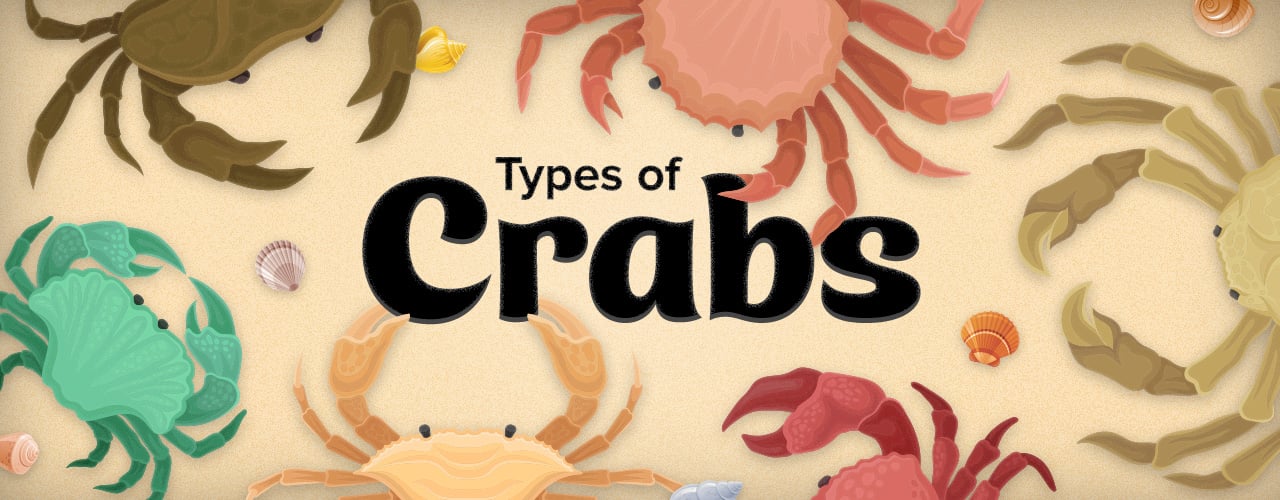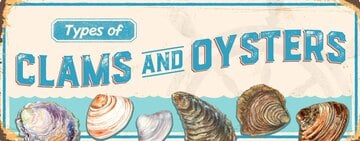Nothing ushers in the summer season quite like a seafood boil. With an array of edible crabs available, it may be challenging to pick the best one for your menu. From the humble peekytoe crab to the gargantuan king crab, we’ll explore the differences between the most common kinds of crabs and how they are best served.
Shop For CrabsTypes of Crabs
While there are hundreds of crab varieties, not all of them are suitable or substantial for cooking. Below, we created a list of the most popular types of edible crabs so you can prepare a menu that will have your seafood-loving customers coming back for more.
1. King Crab

King crabs (Paralithodes camtschaticus) are one of the largest edible crabs you’ll find on a menu. Also known as red king crabs or Alaskan king crabs, they get their name from their notable size, usually weighing anywhere from 6 to 25 pounds. The carapace (the body portion excluding the legs) can measure anywhere from 7 to 11 inches across, with a potential leg span of 5 feet. King crabs are usually found in the icy waters off the coast of Alaska from November through January.
- King Crab Season: November through January
- King Crab Size: 7” - 11” Carapace; 5’ leg span
- King Crab Weight: 6 - 25 lb.
- King Crab Color: Red-brown when alive, vibrant red with white underbelly when cooked
- Where Are King Crabs Found? North Pacific Ocean between Alaska and Russia (Bering Sea, Gulf of Alaska)
Cooking King Crab
Although king crabs have large carapaces, their edible meat is predominately in their legs. When cooking king crab legs, you can steam, bake, boil, or grill them to bring out their subtly sweet flavor. King crab legs are best known for the chunks of firm white meat that can be extracted from the vibrant deep-red shell when cooked. Plate your cooked crab legs with some melted butter and a wedge of lemon for the perfect finishing touch.
- Edible Parts of King Crab: Legs
- What Does King Crab Taste Like? Delicate sweetness, similar to lobster
- How to Prepare King Crab Legs: Steamed, boiled, grilled, or baked
2. Dungeness Crab
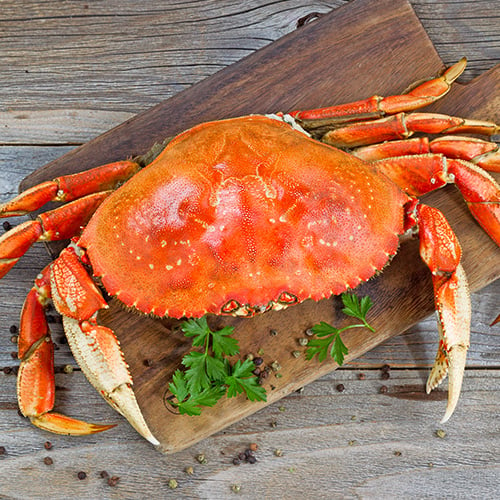
As one of the most abundant types of crabs in the seafood market, Dungeness crabs (Metacarcinus magister) are a popular choice for restaurant menus. They are primarily found along the Pacific Coast of the United States from November through July, with Newport, Oregon claiming the title of “The Dungeness Crab Capital of the World”. Growing to be about 4 pounds and 7 inches in width, only male Dungeness crabs can be legally harvested after they surpass 6 1/4 inches in size to prevent overfishing.
- Dungeness Crab Season: November through July
- Dungeness Crab Size: 6” - 7” (Must be a minimum of 6 1/4” for harvest)
- Dungeness Crab Weight: 1.75 - 4 lb.
- Dungeness Crab Color: Brownish purple when alive, light red-orange with pale claws when cooked
- Where Are Dungeness Crabs Found? Pacific Coast of the U.S. (From Southern California to Alaska)
Cooking Dungeness Crab
While the prominent edible portions of a Dungeness crab are in the legs and claws, the rest of the crab can either be eaten or used in recipes. When they are boiled, steamed, or grilled, their brown shell turns a light red-orange hue. The legs and claws offer dense meat that is slightly sweet and nutty in flavor, pairing perfectly with butter and lemon. The body can be cracked open and picked with seafood tools for additional meat. Many chefs like to save Dungeness crab shells to make a flavorful fish stock.
- Edible Parts of Dungeness Crab: Legs, claws, and body
- What Does Dungeness Crab Taste Like? Sweet and nutty
- How to Prepare Dungeness Crab: Steamed, boiled, or grilled
3. Snow Crab

Snow crabs (Chionoecetes opilio), also known as rock crabs, get their name from the rocky, frigid waters they inhabit and the white color of their meat. Found in the Northern Pacific and Atlantic oceans, snow crabs are usually abundant between October to May. They bear a striking resemblance to king crabs with their long, spindly legs but are much smaller in size. Snow crabs weigh in at only 2 to 4 pounds and feature 6- to 7-inch carapaces.
- Snow Crab Season: October to May
- Snow Crab Size: 6” - 7”
- Snow Crab Weight: 2 - 4 lb.
- Snow Crab Color: Light orange-brown when alive, bright orange-red when cooked
- Where Are Snow Crabs Found? Northern Pacific and Atlantic (Maine to Greenland, Sea of Japan to Bering Sea)
Cooking Snow Crab
Snow crabs or rock crabs are a favorite among crab lovers because of how easy they are to crack. The shell of a snow crab can be cracked by hand, meaning seafood tools aren’t required to extract the snow-white meat. Because of their shell thinness, snow crab legs can be easily overcooked. It is recommended to gently steam them to bring out their sweetness and tenderness before serving with lemon and butter.
- Edible Parts of Snow Crab: Legs and claws
- What Does Snow Crab Taste Like? Subtly sweet and slightly briny
- How to Prepare Snow Crab: Steamed
Snow Crab vs King Crab
Although they look similar, the difference between snow crab and king crab comes down to their size and crackability. Where the king crab usually weighs 6 pounds and has a hard shell that requires tools to crack, snow crabs are usually no more than 4 pounds and have a soft shell that can be cracked by hand. King crabs have thicker legs with distinguishable spines that offer firmer meat than that of snow crabs. The flavor of snow crab has a slightly more briny flavor than king crab meat.
4. Blue Crab
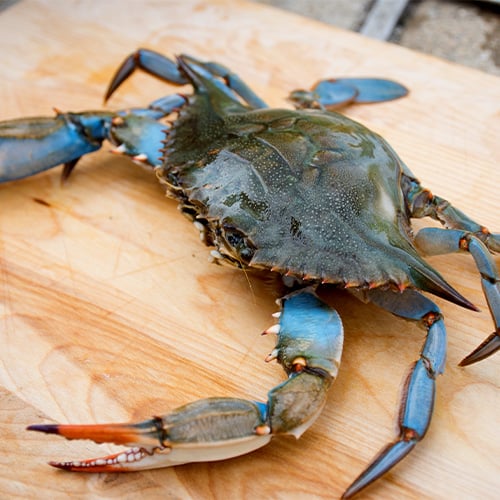
Blue crabs (Callinectes sapidus) are a staple of the Chesapeake Bay off the coast of Maryland but can be found along the east coast of the U.S. Their name comes from the vibrant blue-green color of their shells which turn a bright red when cooked. Blue crabs are usually no more than 6 inches in size and 1 pound in weight. They are harvested between June to October, with the molting season occurring predominantly during the spring. Molted crabs (crabs that have shed their hard exoskeleton) are what chefs would list as soft shell crabs on a menu and are considered a delicacy.
- Blue Crab Season: June to October (Molting from May to September)
- Blue Crab Size: 3” - 6”
- Blue Crab Weight: .25 - 1 lb.
- Blue Crab Color: Blue-green when alive, red with white speckles when cooked
- Where Are Blue Crabs Found? Eastern Atlantic Coast of the U.S. (Primarily in Chesapeake Bay)
What Is a Soft Shell Crab?
Soft shell crabs are blue crabs that have molted (shed their hard outer shell). Blue crabs are only considered to be soft shelled for 12 hours after molting. When harvesting blue crabs, fishermen look for a line on the paddler fin that turns from white to red to know if they are about to molt. Recently molted blue crabs have incredibly soft shells, meaning that every part, with the exception of their lungs and gills, is edible. This makes soft shell crabs a hot commodity in the spring and summer months.
Cooking Blue Crab
Perfect for seafood boils, hard shell blue crabs are usually steamed or boiled with Old Bay seasoning before the succulent crab meat is picked. Their soft white meat bears a rich and nutty flavor and is full of protein and Omega-3 fatty acids. Soft shell crabs can be fried in batter or sauteed whole and served with melted butter. Soft shell crabs have a satisfying crunch that crab-enthusiasts enjoy.
- Edible Parts of Blue Crab: Legs, claws, body, and shell when molted
- What Does Blue Crab Taste Like? Rich, succulent, with mild nuttiness
- How to Prepare Blue Crab: Steamed or boiled when hard shell, fried or sauteed when soft shell
5. Stone Crab
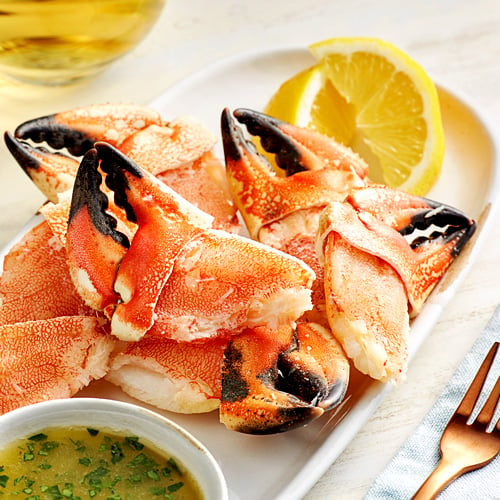
Stone crabs (Menippe mercenaria), often referred to as Florida stone crabs or Gulf stone crabs, are prized for their claws and unique claw regeneration abilities. Predominately found off the coast of Florida between October to May, fishermen twist off just one of the stone crab’s claws before throwing them back, leaving the other claw for defense. A new claw will regenerate within 18 months of the previous one being removed. Stone crabs usually grow to 3 to 4 inches in size but claws must be a minimum of 2 3/4 inches long to be harvested.
- Stone Crab Season: October to May
- Stone Crab Size: 3” - 4” (Claws must be 2 3/4” for harvest)
- Stone Crab Weight: .2 - 5 lb.
- Stone Crab Color: Dark red-brown with white underbelly when alive, pale red-orange with black claws when cooked
- Where Are Stone Crabs Found? Gulf of Mexico and Southern Atlantic Coast of U.S (Primarily around Florida)
Cooking Stone Crab Claws
Stone crab claws make an eye-catching addition to seafood trays and towers. Only their claws are edible and are best when boiled or steamed. Serve stone crab claws on ice with lemon, mustard sauce, and the appropriate seafood tools to crack them. Stone crab claw meat has a hearty texture and subtle sweetness akin to shrimp or lobster.
- Edible Parts of Stone Crab: Claws
- What Does Stone Crab Taste Like? Subtly sweet, like shrimp or lobster
- How to Prepare Stone Crab: Steamed or boiled
6. Peekytoe Crab
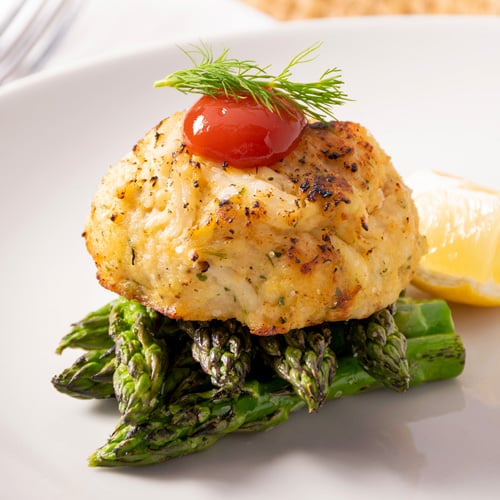
Peekytoe crabs (Cancer irroratus), also known as Atlantic rock crabs or sand crabs, used to be considered a throw-away species in the fishing industry. Formally known as Maine rock crabs, they didn’t ship well alive and were considered a pest in lobster pots. However, once it was discovered that their meat could be steamed and picked upon catching, the peekytoe was given its whimsical name and became highly in demand. Peekytoe crabs are usually found from August to November in the Northern Atlantic Ocean, from Nova Scotia to Rhode Island. Relatively small in size, peekytoe crabs are usually only 3 to 5 inches wide and around half a pound in weight.
- Peekytoe Crab Season: August to November
- Peekytoe Crab Size: 3”- 5”
- Peekytoe Crab Weight: .2 - 5 lb.
- Peekytoe Crab Color: Pale orange-brown when alive, white and pink meat when picked
- Where Are Peekytoe Crabs Found? Northern Atlantic Ocean (Nova Scotia to Rhode Island)
Cooking Peekytoe Crab
Because they are cleaned and picked when they are caught, peekytoe crab meat is relatively expensive and usually only sold fresh to restaurants directly. It can also be canned and shipped after picking. The sweet and tender peekytoe crab meat is perfect for shredding over salads or forming into delicious crab cakes.
- Edible Parts of Peekytoe Crab: Legs and claws
- What Does Peekytoe Crab Taste Like? Subtly sweet and briny
- How to Prepare Peekytoe Crab: Baked or roasted
Find the perfect seafood for your restaurant with the help of our crab guide. With the different crab varieties available, there is sure to be one that will really impress the crab-lovers in your area. Kick off the warmer months with delicious crab recipes to create an unforgettable seafood menu.
